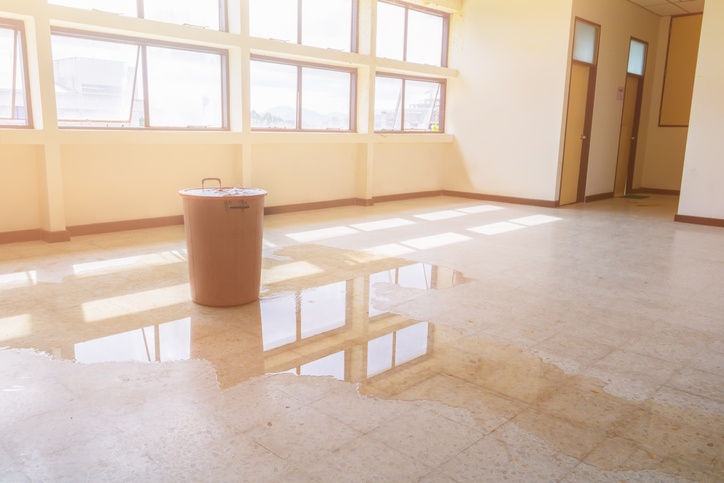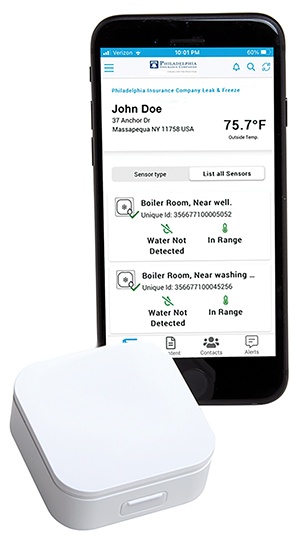
Simple-to-place, easy-to-use sensors — in critical spots on a church campus — can help prevent catastrophic water damage

ARM, AIS
Vice President
Philadelphia Insurance Companies (PHLY)
Church Executive: Tell us about the PHLYSense sensor system — when and why it was developed, and what it does.
Andrew Shockey: PHLYSense was officially deployed in the fourth quarter of 2020 after several years of trial-and-error with the technology which — like all things tech — had gotten faster, better and cheaper over that time.
PHLYSense is simply a water and temperature sensor system that is placed inside of a building or property to detect the presence of water or a drop in the interior temperature of the building that might indicate a pipe-freeze situation. In those cases, it sends a notification to the person(s) listed as contacts in the app.
CE: Is there a limit to the number of sensors provided to each church client?
Shockey: No; but the good news is, you don’t need a sensor for every plumbing fixture within a building. It’s a simple program to start and also easy to use. No plumber is required, and these sensors can be moved around within the building.
CE: Does placing the sensors have any effect on a church policyholder’s premiums?
Shockey: We don’t have a line-item discount for policyholders who use PHLYSense, but it is a factor that our underwriters see and appreciate when evaluating a church’s overall risk and executing their craft of writing a property line of coverage.
CE: Where, ideally, would these sensors be placed on a church campus?
Shockey: We start by asking our church clients where they would least appreciate the presence of water or a sudden temperature drop. (They know their buildings the best.) It can be as simple as thinking, If somebody were to leave a bathroom window open on an exterior wall — and there is a pipe nearby — let’s place one there. Or — depending where it’s located and if there are pipes nearby — maybe place a sensor on the organ, typically one of the highest-value assets within a church.
 Another lifesaving solution
Another lifesaving solution
As an insurer committed to providing policyholders with innovative solutions to combat common risks, Philadelphia Insurance Companies (PHLY) has recently partnered with LifeVac, an airway clearance device, to do just that.

“Many churches have kitchens that they use themselves or rent out for use by other organizations,” says PHLY Vice President Andrew Shockey. “LifeVac doesn’t replace other rescue methods — like the Heimlich maneuver and proper food preparation — but it’s another simple ‘tool in the box’ to use for both children and adults.”
Recently, LifeVac was used at a homeless shelter following an unsuccessful Heimlich maneuver attempt on an infant; it immediately dislodged a blockage in the baby’s throat. “So this is something we’d eventually like to see right next to the AED in the churches,” Shockey says. “The retail price point is such that our policyholders can use our code and get it down to just over $50 with taxes — not terribly high for a lifesaving device.”
PHLY policyholders are eligible to to receive an exclusive 25% discount on any order of the LifeVac devices, kits or bundles.
CE: Who typically places these sensors in a church?
Shockey: Usually, it’s the same people who sign up to receive alerts in the PHLYSense app. Often this is office managers, trustees — people who are directly charged with the care of the structure.
 CE: Speaking of the “alerts” feature, who typically signs up to receive those?
CE: Speaking of the “alerts” feature, who typically signs up to receive those?
Shockey: Often it’s the same people who place the sensors, plus some others. That way, if a sensor alerts and a recipient is on vacation, several other people also get that notice.
What’s also nice is, within the app, the location of each sensor is noted in the policyholder’s own words. So if he or she is out of town when an alert goes off, whoever else comes to the church to check it out knows right where to go rather than searching the whole building.
CE: What is it about church facilities that make them particularly good candidates for solutions like sensors?
Shockey: PHLYSense is ideal for buildings that are largely “vacant” during the week, in the sense that there isn’t constant foot traffic.
Also, a lot of churches are a little bit older, and this technology can help protect some of the most vulnerable areas in aging buildings — especially if a permanent solution isn’t feasible at the moment.
PHLYSense technology allows an extension of care to trustees, particularly.
Churches are buildings that bring people together. They enable congregations to continue to fulfill their mission. If something as simple as a little white box and a cell phone app can help protect all that, why not?
CE: Is there anything we haven’t discussed but that is important to mention?
Shockey: I think your readers are aware (or will be reminded soon) about the extreme pressures on property lines of coverage, resulting in increased premiums. What I’d like them to hear — certainly as PHLY clients — is that we’re committed to working together with our church clients as we tackle these very challenging times.
We’re not going to solve supply chain issues today, for example; rather than giving up and deciding a rate increase is the only solution, what else can we be doing, together? Beyond PHLYSense, we’re constantly looking at other ways to augment our policyholders’ experience while still being very responsible about our rates and policy terms.
— Reporting by RaeAnn Slaybaugh


